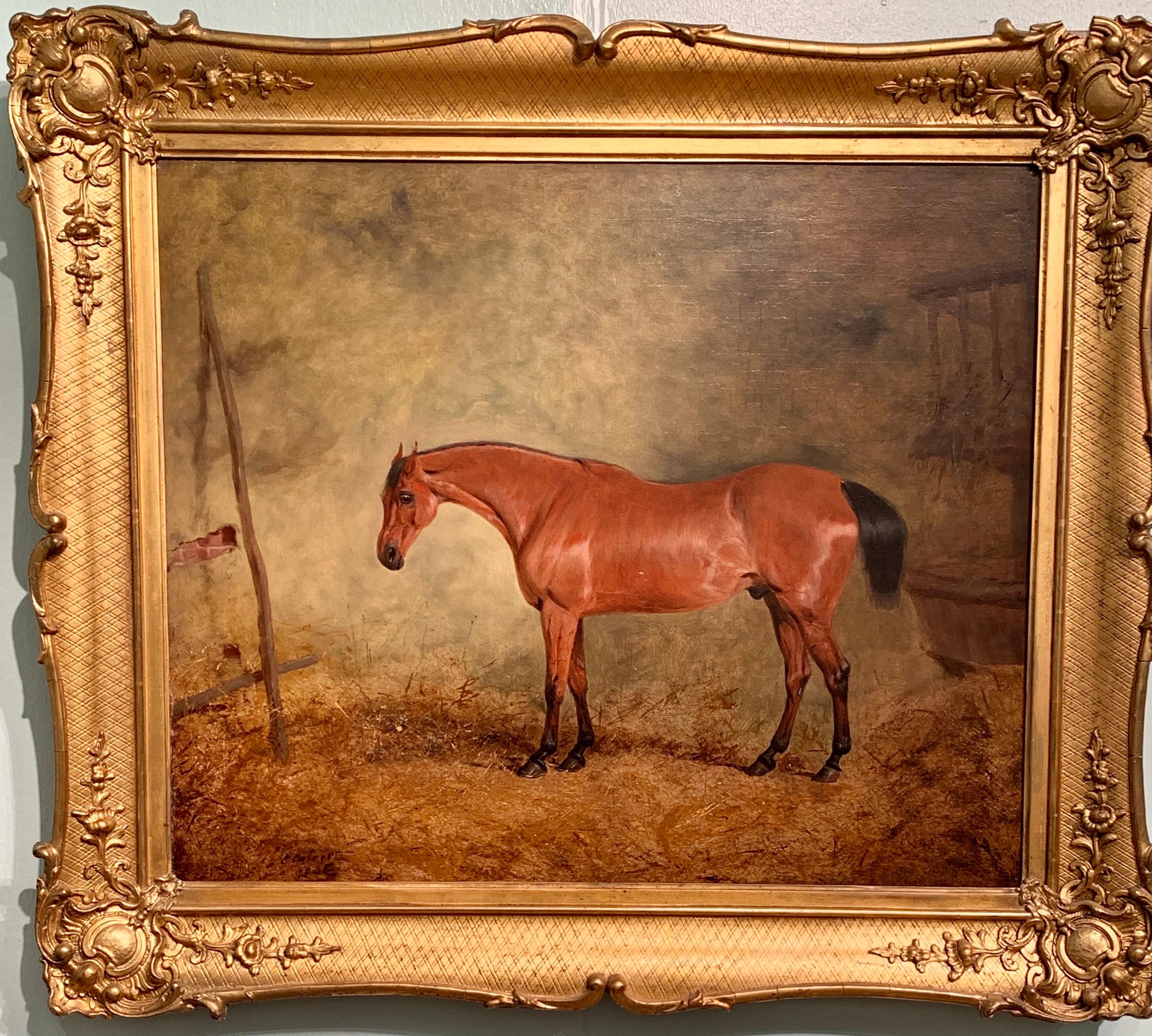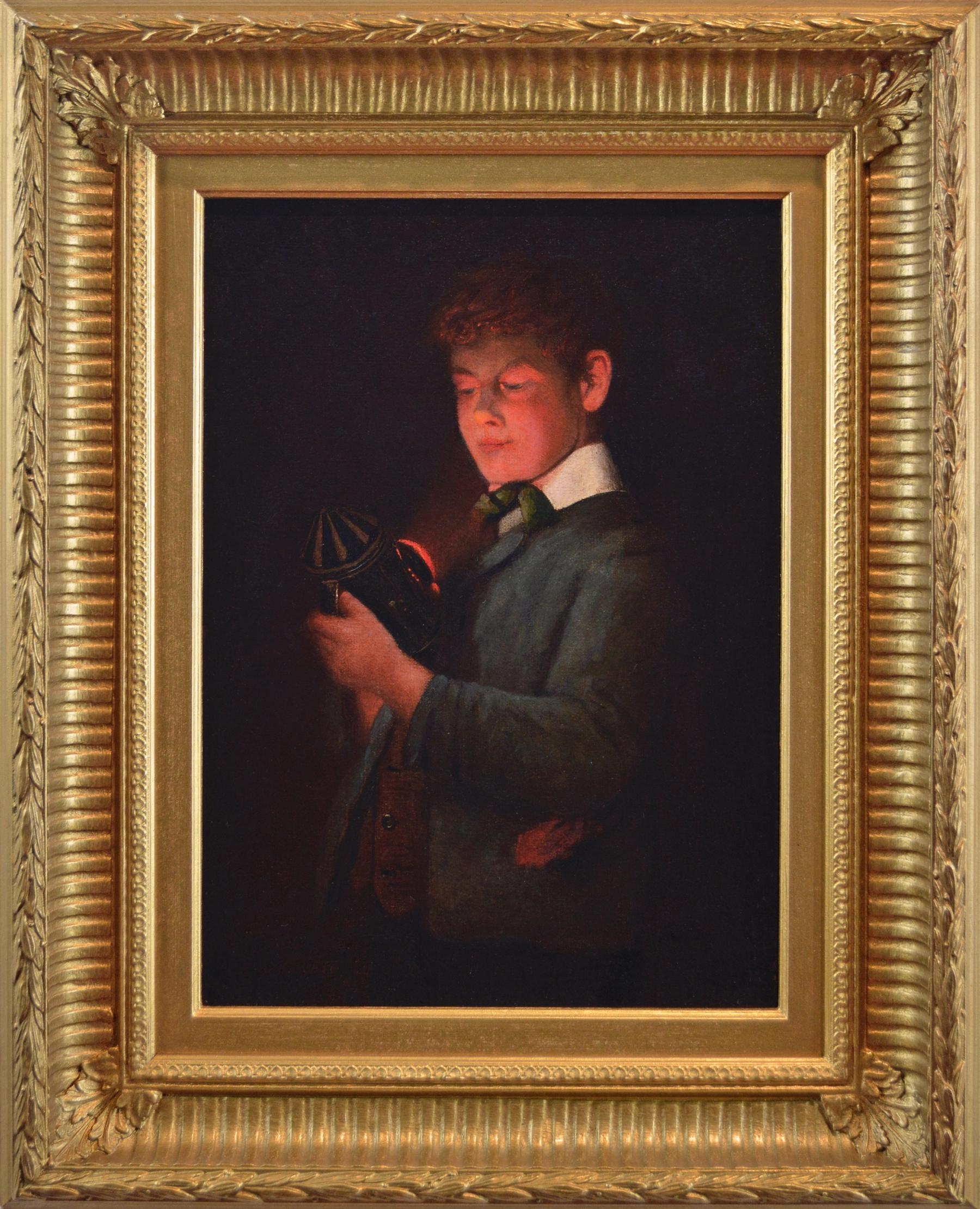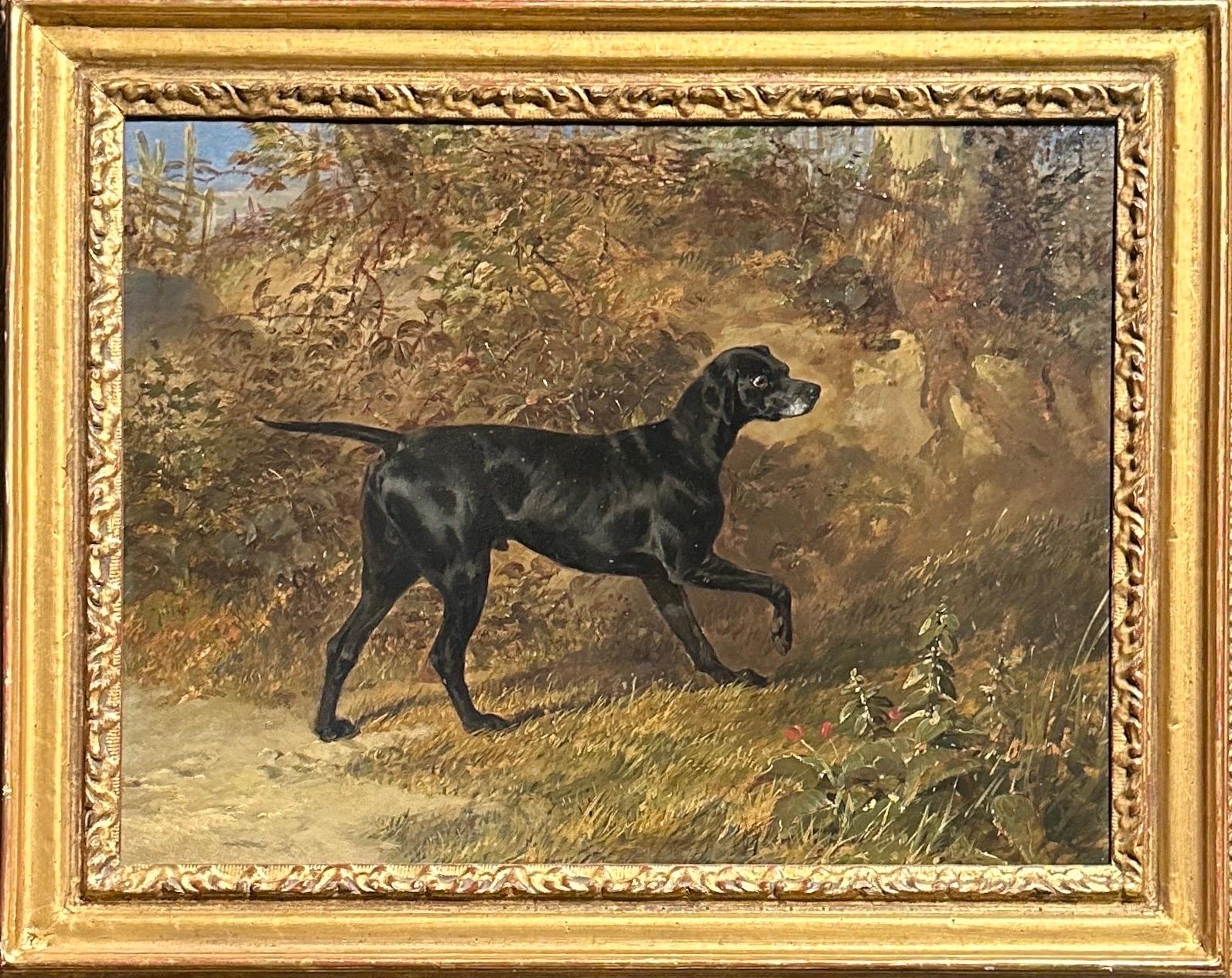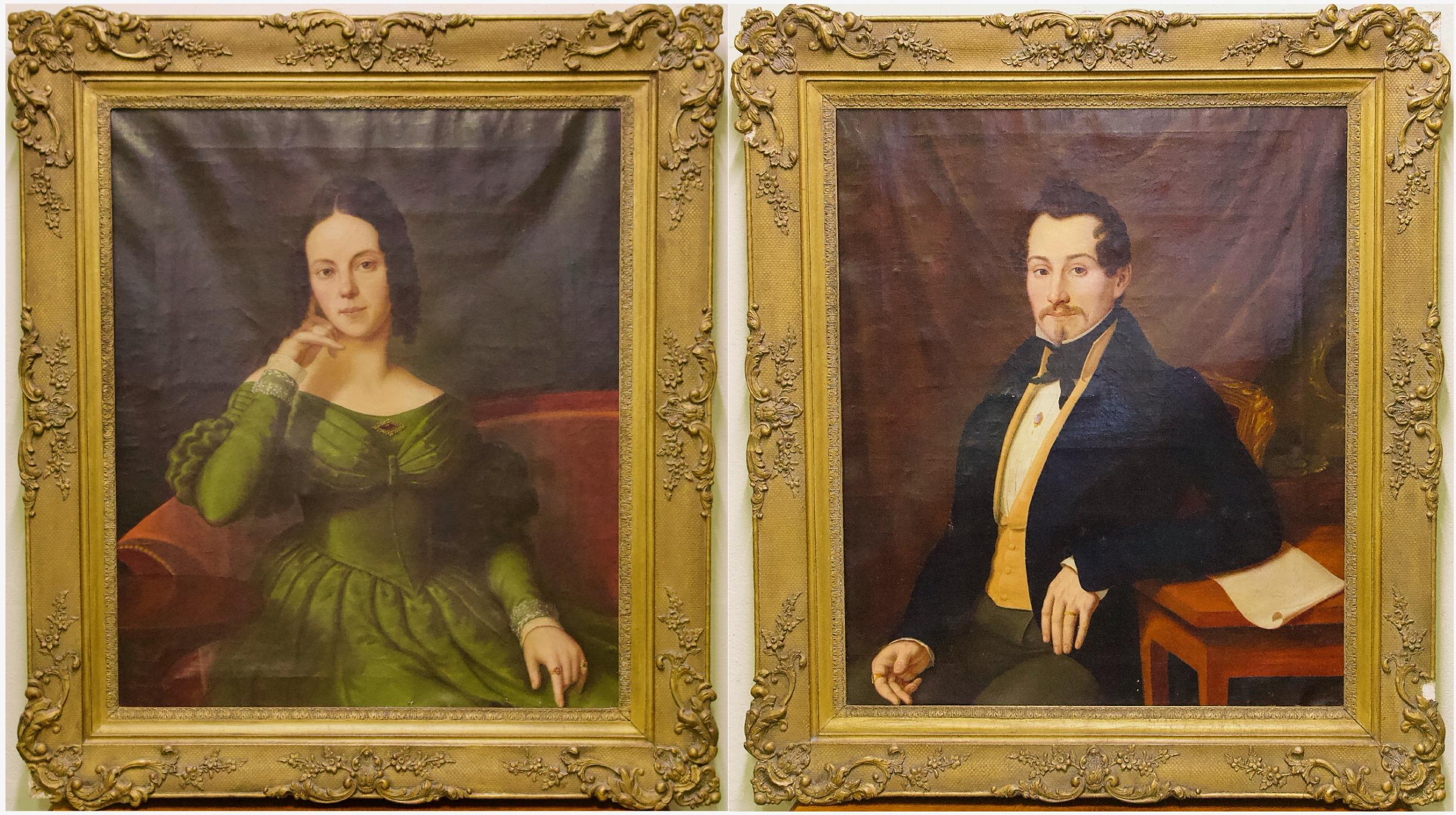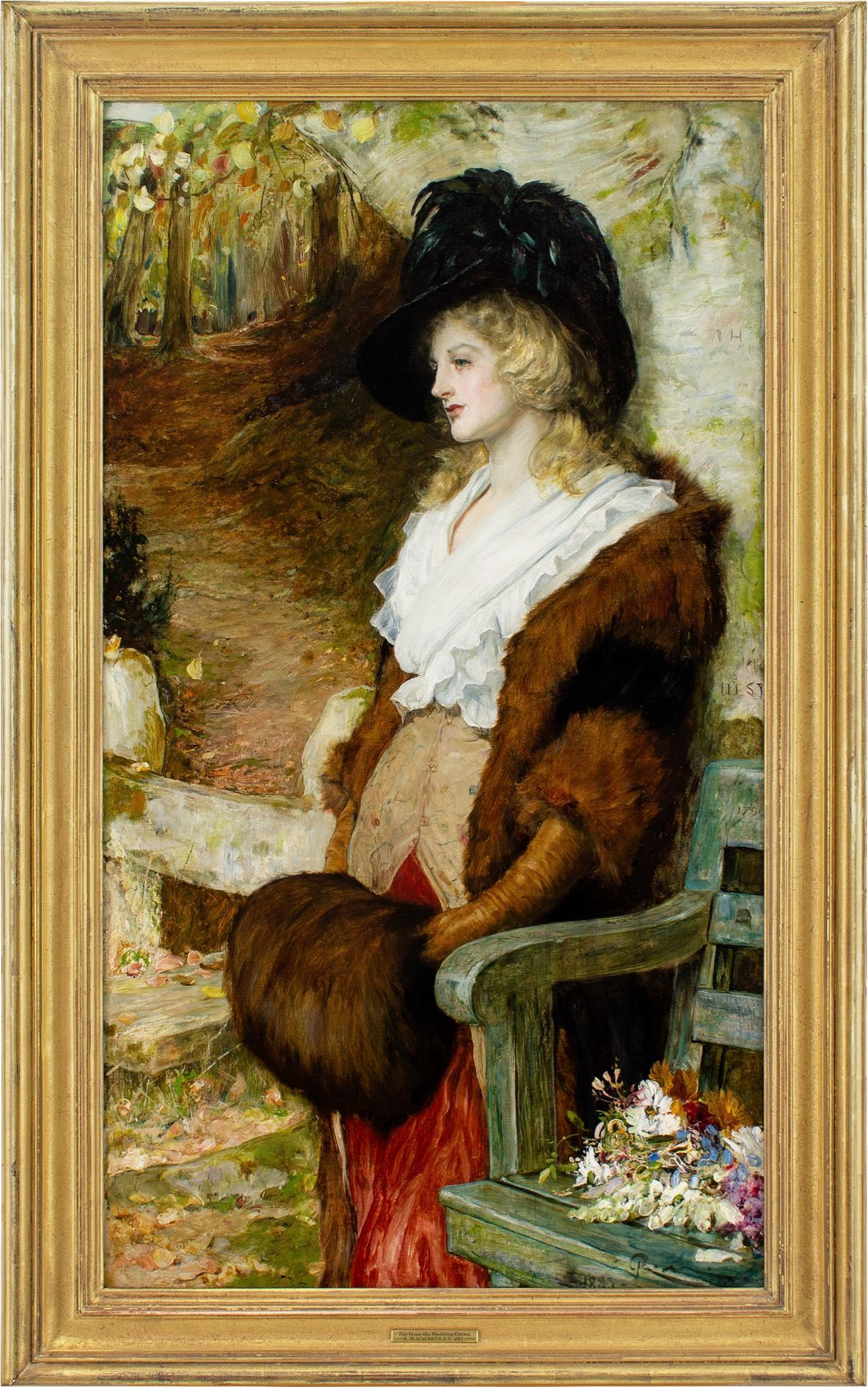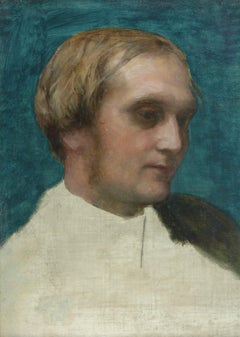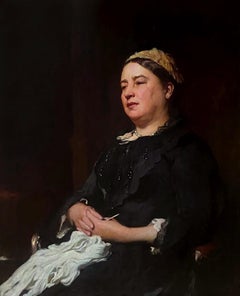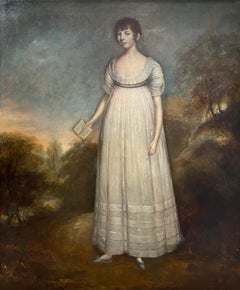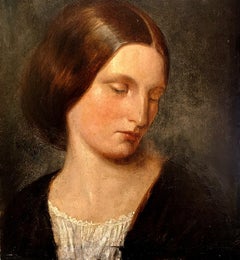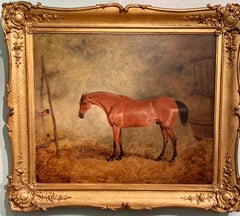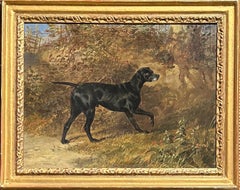Items Similar to Una
Want more images or videos?
Request additional images or videos from the seller
1 of 8
Richard WallerUna1879
1879
About the Item
Richard Waller
1811 - 1882
Una
Oil on canvas, signed lower right and dated 1879
Image size: 23 1/2 x 19 1/2 inches (59.5 x 49.5 cm)
Original frame
Una is one of the main characters in the first book of Edmund Spenser's The Faerie Queene. She is the personification of the "True Church". Una travels with the Redcrosse Knight (who represents England), whom she has recruited to save her parents' castle from a dragon. She also defeats Duessa, who represents the "false" (Catholic) church and the person of Mary, Queen of Scots, in a trial reminiscent of that which ended in Mary's beheading. Una is also representative of Truth.
Painter of landscape, genre and portraits. Waller was born in Birmingham, where he also studied. He exhibited widely, including at the Royal Academy between 1845 and 1868. His paintings were often reproduced in 'The London Evening News'.
- Creator:Richard Waller (British)
- Creation Year:1879
- Dimensions:Height: 23.5 in (59.69 cm)Width: 19.5 in (49.53 cm)
- More Editions & Sizes:1 of 1Price: $7,333
- Medium:
- Movement & Style:
- Period:
- Condition:
- Gallery Location:London, GB
- Reference Number:1stDibs: LU52410617232
About the Seller
5.0
Gold Seller
Premium sellers maintaining a 4.3+ rating and 24-hour response times
Established in 2007
1stDibs seller since 2014
80 sales on 1stDibs
Typical response time: 5 hours
- ShippingRetrieving quote...Shipping from: London, United Kingdom
- Return Policy
Authenticity Guarantee
In the unlikely event there’s an issue with an item’s authenticity, contact us within 1 year for a full refund. DetailsMoney-Back Guarantee
If your item is not as described, is damaged in transit, or does not arrive, contact us within 7 days for a full refund. Details24-Hour Cancellation
You have a 24-hour grace period in which to reconsider your purchase, with no questions asked.Vetted Professional Sellers
Our world-class sellers must adhere to strict standards for service and quality, maintaining the integrity of our listings.Price-Match Guarantee
If you find that a seller listed the same item for a lower price elsewhere, we’ll match it.Trusted Global Delivery
Our best-in-class carrier network provides specialized shipping options worldwide, including custom delivery.More From This Seller
View AllPortrait of Herbert Fisher, Mid-19th Century Oil Painting, Original Watts Frame
By George Frederic Watts
Located in London, GB
Oil on canvas
c.1855 - 1860
Image size: 19 x 14 inches (48.25 x 37.25 cm)
Original Watts frame
The Sitter
Herbert William Fisher (1826 - 1903) was a British historian, best known for his 'Considerations on the Origin of the American War' (1865). Fisher was tutor to the future King Edward VII, and served as Private Secretary to the 5th Duke of Newcastle. in 1863 he became Private Secretary to the Prince of Wales, his former pupil, before being appointed to the position of Vice-Warden of the Stannaries in 1870. One of his daughters, Adeline, married Ralph Vaughan Williams.
George Frederick Watts
Watts (1817 - 1904) was a British painter and sculptor associated with the Symbolist movement. He is known to have said 'I paint ideas, not things'. Watts became famous in his lifetime for his allegorical works, such as 'Hope' and 'Love and Life' in which the emotions and aspiration life were intended to be represented in a universal symbolic language.
Watts was born in Marylebone in central London on the birthday of George Frederic Handel (after whom he was named), to the second wife of a poor piano-maker. He showed artistic promise very early, learning sculpture from the age of 10 with William Behnes, starting to study devotedly the Elgin Marbles (later writing "It was from them alone that I learned") and then enrolling as a student at the Royal Academy Schools at the age of 18.
He first exhibited at the Academy in 1837, with a picture of "The Wounded Heron" and two portraits, but his attendance at the Academy was short-lived, and his further art education was confined to personal experiment and endeavour, guided by a constant appeal to the standard of ancient Greek sculpture. He also began his portraiture career, receiving patronage from his close contemporary Alexander Constantine Ionides, who later came to be a close friend. In 1849 the first two of the allegorical compositions which form the most characteristic of the artist's productions were exhibited—"Life's Illusions," an elaborate presentment of the vanity of human desires, and "The people that sat in darkness," turning eagerly towards the growing dawn. In 1850 he first gave public expression to his intense longing to improve the condition of humanity in the picture of "The Good Samaritan" bending over the wounded traveller; this, as recorded in the catalogue of the Royal Academy, was "painted as an expression of the artist's admiration and respect for the noble philanthropy of Thomas Wright, of Manchester," and to that city he presented the work. From the late 1840s onward he painted many portraits in France and England, some of which are described below. Notable pictures of the same period are “Sir Galahad...
Category
1850s Victorian Portrait Paintings
Materials
Canvas, Oil
Portrait of Miss Tonks, Signed and dated 19th Century Oil
Located in London, GB
Oil on canvas, signed and dated lower right 1882
Image size: 36 x 29 inches (92 x 74 cm)
Gilt Watts frame
LITERATURE
The Life and Work of Frank Holl, Ada ...
Category
19th Century Victorian Portrait Paintings
Materials
Canvas, Oil
Portrait of a Girl with Book, 18th Century Regency Oil Painting
Located in London, GB
Oil on canvas
Image size: 28 3/4 x 24 inches (73 x 61 cm)
Contemporary style gilt frame
This portrait is an evocative example of Devis' Regency period portraiture, featuring a pleasant looking young girl holding a book in an outdoor setting.
Working with a darker palette, a strongly accented diagonal recession, and dramatic contrasts of light and shadow, Devis heightens the girl's three-dimensional physical presence in the foreground of the composition.
The Artist
Arthur William Devis (10 August 1762 – 11 February 1822) was an English painter of history paintings and portraits. He painted portraits and historical subjects, sixty-five of which he exhibited (1779–1821) at the Royal Academy. Among his more famous works are a depiction of the Death of Nelson and a posthumous portrait of Nelson.
Devis was born in London, the nineteenth child of the artist Arthur Devis and his wife Elizabeth Faulkner. Devis was the younger brother of the painter Thomas Anthony Devis (1757–1810) and of the schoolmistress and grammarian Ellin Devis (1746–1820), teacher, among others, of author of Maria Edgeworth and Frances Burney (later novelist Madame d'Arblay).
He followed his elder brother Thomas Anthony in becoming a pupil at the Royal Academy Schools in 1774 and like his brother exhibited at the Free Society of Artists, of which in 1768 their father had become president, and at the Royal Academy. Early on he came to the notice of Sir Joshua Reynolds.
He was appointed draughtsman on the British East India Company's packet Antelope in a voyage in 1783, under Captain Henry Wilson. In her he was injured in an encounter with Papuans near the Schouten Islands and was then wrecked on the Pelew Islands before proceeding to Canton and thence to Bengal. During his voyages, the artist received arrow wounds, one of which inflicted permanent injury on his lower jaw. During his time in Bengal, he painted a portrait of Sir William Jones, at the time a judge in Fort William. The painting now hangs at the British Library.
He was back in London by 1795 and is recorded on 21 July 1797 as living at 27 George Street, Hanover Square, where he was insured by the Sun Assurance Office.
He is noted for his involvement in the creation of the posthumous cult of Horatio Nelson. As she returned from Trafalgar, Devis went out to meet HMS Victory and was present on board the ship during the autopsy of Nelson's body conducted by Dr Beatty, the ship's surgeon. With the help of sketches he took at that time, he painted a heroic Death of Nelson, which proved a sensation.
Devis also painted Dr Beatty, and was commissioned by him to produce a half-length painting of Nelson as vice-admiral, which he lent to Emma Hamilton (who later lost it in an accident whilst travelling). Either the original or a copy of this portrait was exhibited at the Royal Academy two years after the Battle and many copies were made of it. Lord Howe owned one, and another ended up in the collection of the National Maritime Museum. It also appeared as an engraving in Beatty's published account of Nelson's death.
Other work includes a portrait of King George III on horseback, and a range of portraits of admirals and generals, along with historical subjects, such as the Babington Plot and the signing of the Magna Carta...
Category
18th Century Victorian Portrait Paintings
Materials
Canvas, Oil
Portrait of a Mary Hardy (nee Sulman), Late 19th Century Victorian Oil
Located in London, GB
Slade School
Late 19th Century
Portrait of a Mary Hardy (nee Sulman)
Oil on panel
Image size: 8 x 7 inches
Contemporary frame
Provenance
Lady Town (Grandda...
Category
Late 19th Century Victorian Portrait Paintings
Materials
Oil, Panel
Self Portrait
By Gerald Goddard Jackson
Located in London, GB
Gerald Goddard Jackson
1878-1941
Self Portrait
Oil on canvas
Image size: 23½ x 19½ inches
Original frame
Jackson was born at Duddington, Northamptonshire on 5 March 1878. He enrolled at the Slade School of Art in 1893 where he studied alongside fellow students Wyndham Lewis, Orpen, Gertler, Nash and Nevinson. He left the Slade in 1899 in order to travel to Canada, USA and Mexico, spending three years in Italy.
In 1911, he joined the Army. Upon the outbreak of the First World War, his battalion was sent to France. He was captured in 1916 and was held at various German prisoner of war camps, largely at Schwarmstedt in Saxony. Whilst in captivity he befriended the poet Frederick William Harvey...
Category
20th Century Portrait Paintings
Materials
Oil, Canvas
Portrait of a Gentleman Commoner at Oxford, 18th Century Oil on Canvas
By James Northcote b.1746
Located in London, GB
James Northcote
Portrait of a Gentleman Commoner at Oxford
Oil on canvas
Image size: 30 x 25 inches (76 x 63.5 cm)
Original gilt frame
This painting is a comparatively rare example ...
Category
18th Century English School Portrait Paintings
Materials
Canvas, Oil
You May Also Like
19th Century English Antique Bay Hunter horse in a stable, called Business
By Henry Calvert
Located in Woodbury, CT
Henry Calvert was an animal painter, particularly of the sporting variety and best known for his depictions of horses, hunting scenes and equestrian hunting portraits...
Category
1840s Victorian Animal Paintings
Materials
Oil, Canvas
$14,000 Sale Price
20% Off
Free Shipping
Late 19th Century genre portrait oil painting of a boy holding a lantern
By Charles Spencelayh
Located in Nr Broadway, Worcestershire
Charles Spencelayh
British, (1865-1958)
The Lantern
Oil on canvas, signed
Image size: 13.5 inches x 9.75 inches
Size including frame: 20.25 inches ...
Category
Late 19th Century Victorian Figurative Paintings
Materials
Oil, Canvas
English 19th century portrait painting of a Pointer dog in a woodland landscape
By John Frederick Herring Sr.
Located in Bath, Somerset
A black pointer in a woodland landscape by John Frederick Herring Senior, circa 1830. Oil on canvas in a giltwood frame.
Provenance:
Arthur Ackerman and Son
Frost and Reed
Blains, Bruton Place, London
John Frederick Herring, born in London in 1795, was the son of a London merchant of Dutch parentage, who had been born overseas in America. The first eighteen years of Herring's life were spent in London, where his greatest interests were drawing and horses. In 1814, at the age of 18, he moved to Doncaster in the north of England, and by 1815, had married Ann Harris. His sons John Frederick Herring Jr., Charles Herring, and Benjamin Herring...
Category
1830s Victorian Animal Paintings
Materials
Oil, Canvas
Pair of Antique Paintings, Oil on Canvas, Portraits. Around 1850.
Located in Berlin, DE
Pair of antique paintings, oil on canvas, portraits. Around 1850.
Portrait of a well-known artist and his wife.
Dimensions are per painting...
Category
19th Century Victorian Portrait Paintings
Materials
Canvas, Oil
$3,490 Sale Price
21% Off
Free Shipping
19th century English Antique oil portrait of a white Terrier Dog
Located in Woodbury, CT
19th century English Antique oil portrait of a Terrier dog in an interior
Earl was the brother of George Earl and the uncle of Maud Earl and Percy Earl. H...
Category
1870s Victorian Animal Paintings
Materials
Canvas, Oil
Robert Walker Macbeth RA ROI RWS, Far From The Madding Crowd
Located in Cheltenham, GB
This spellbinding late 19th-century oil painting by Scottish artist Robert Walker Macbeth RA ROI RWS (1848-1910) depicts a young woman wearing...
Category
1880s Victorian Portrait Paintings
Materials
Canvas, Oil
Recently Viewed
View AllMore Ways To Browse
Richard Waller
Antique Victorian Wall Art
Antique Catholic Art
Victorian Painted Book
Antique Catholic Painting
Victorian Dragon
Richard Waller Oil Portrait
Queen Mary Portrait
Save The Queen
Mary Of Scots
Mary Queen Of Scots
Royal Scot
Queen Mary Of Scots Portrait
Mary Queen Of Scots Oil Paintings
Football Portrait
Portrait Rococo Frame
English Gentleman Portrait
Queen Mary I
